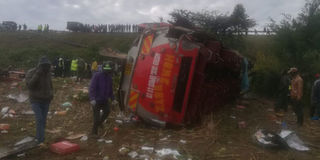Night horrors: Concern as road crashes claim hundreds of lives

Fifty eight people died after a bus that was travelling from Nairobi to Kisumu crashed at Fort Ternan on Londiani-Muhuroni Road on Wednesday, October 10, 2018. PHOTO | FILE | NATION MEDIA GROUP
What you need to know:
A number of the serious accidents have occurred on Kenyan roads at night this year, with hundreds of fatalities.
- Today marks exactly one year since NTSA proposed a ban on night travel.
According to the transport agency, the ban sought to reduce fatalities by more than 50 per cent.
Upsetting memories of the horror crash of the school bus belonging to St Gabriel Academy in Mwingi, Kitui County, in August this year are still raw in the minds of many Kenyans.
The pupils were returning to school from a trip in Mombasa when a truck collided with the bus at a bridge about one kilometre from Mwingi town. The bus rolled several times before plunging into a dry river bed. Eleven pupils were killed and tens of others injured in the midnight incident.
MANGLED WRECKAGE
In July, 10 people died and more than 20 others were injured when a bus burst into flames after a head-on collision with a truck at Sultan Hamud along the Nairobi-Mombasa highway.
But it is the freak dawn crash at Fort Ternan in Kericho County in October, where 58 people perished, that has become the indisputable emblem of the horror of road accidents in Kenya this year.
When day broke, the comprehensively mangled wreckage lying several metres from the road spoke of the violence that had taken place as the ill-fated bus wheeled dangerously down the notorious 15-kilometre stretch of road between Siret and Muhoroni.
Debris strewn all over, the sheer number of fatalities and heart-rending tales of survivors are all hard to forget.
Yet these are just a handful of the horrors that have occurred on Kenyan roads at night this year, with hundreds of fatalities.
Today marks exactly one year since the National Transport and Safety Authority (NTSA) imposed a ban on night travel on December 31, 2017.
BUS COMPANIES
According to the transport agency, the ban sought to reduce fatalities by more than 50 per cent. NTSA cited violation of traffic rules including careless driving, overloading and fewer traffic officers manning the roads at night for the chaos.
Traders and bus companies strongly protested, arguing that the ban would hurt their businesses. Activist Okiya Omtata successfully petitioned the ban in court.
Justice Chacha Mwita barred NTSA and the National Police Service from effecting the ban. He added that the government had failed to put measures in place to cushion traders and transporters from losses that the proposed ban would cause them.
While the ruling was a reprieve for bus companies and traders, the situation has only grown grimmer by the day, with night travellers being butchered on the roads every week.
In the Fort Ternan incident, for instance, the driver was said to be 72 years old and haggard from a double shift. It also emerged that the bus belonging to Western Crossroads Express Sacco had not been licensed to operate at night.
A similar night ban had been placed in 2013 by the government. But this one too did not last for long even after the number of fatal crashes dramatically fell.
In January this year, President Kenyatta ordered NTSA out of the roads and asked traffic police to take charge.
NTSA director-general Francis Meja has repeatedly blamed the court for reversing the ban, saying that the decision had left the agency’s efforts to ensure road safety in disarray.
“Statistics clearly show that these fatal accidents happen mostly at night. From our analysis, most of these crashes occur between 8pm and 11pm and after midnight, which is what we wanted to stop,” Mr Meja observed.
REGULATIONS
One year on, bus companies continue to operate at night, but also giving way to unlicensed operators. Some quarters believe that this illegal night-time travel is a failure by NTSA, a claim that Mr Meja dismisses.
“NTSA is not an enforcement agency. Our mandate is to institute appropriate policy to ensure safety on the roads. Enforcement of these transport regulations is the work of traffic police and other agencies,” Meja told the Nation.
Despite the setback suffered in court, the director remains confident that the ban will eventually take effect. “We hope to review the ban and to iron out the rough edges before implementing it. The ban is in the interest of Kenyans. It is not meant to inconvenience travellers and traders but to cushion them from the risk of loss of life and property,” Mr Meja said.
According to the director, fewer bus companies applied for licenses for night travel this festive season, unlike in the years before, owing to a set of stringent requirements that the agency has rolled out.
“Operators must have proper fleet management arrangement to obtain a licence to transport Kenyans at night. Bus companies have a responsibility to monitor speed and other parameters of their vehicles on the roads. NTSA also requires them to be in touch with entities such as Red Cross for assistance during emergencies at night,” Meja said.
The jury is still out on whether banning night travel is the answer but Mr Meja believes that discipline by all motorists will ultimately ensure road safety for all users.





